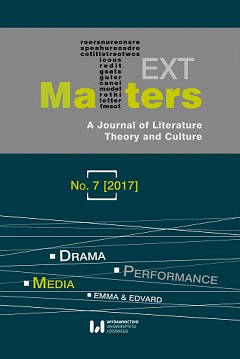Wawel Meets Elsinore. The National and Universal Aspects of Stanisław Wyspiański’s Vision of Shakespeare’s Hamlet
DOI:
https://doi.org/10.1515/texmat-2017-0012Keywords:
Hamlet, Wyspiański, Shakespeare, the dilemmas of nationalism, old-fashioned heroism vs. modernityAbstract
The aim of this paper is to show the role, the possibilities and the limits of Wyspiański’s national thinking through Shakespeare’s Hamlet. Of particular importance, in this context, is the role the Ghost takes in Wyspiański’s celebrated interpretation of Shakespeare’s Hamlet. By the Ghost we mean the spirit of history, the ghost of a father, the spirit of the fatherland, the voice of the ancestors, and particularly that of the Polish king Casimir the Great, as well as the Holy Ghost and the Evil Spirit because all these aspects of the Ghost belong to Wyspiański’s vision. The play in question bears witness to what the Polish poet calls “the truth of other worlds,” as well as the truth of the theatre, which Wyspiański calls the labyrinth. The poet manages to reduce, to some extent, this difficult truth to the truth of the world he cared most about, that is the present and historical reality of Poland, more specifically the city of Cracow, known as Poland’s spiritual, that is “ghostly,” and only virtual, capital. It is also remarkable that Wyspiański saw the Ghost in Hamlet in the context of other Shakespearean ghosts, apparitions and magicians, such as those that appear in Macbeth, The Tempest, Julius Caesar, A Midsummer Night’s Dream or Richard III. At the same time, Wyspiański realizes that the Ghost, with its irrationalism, offends the spirit of post-medieval times, and as such, is understandably neglected by Hamlet, who for Wyspiański, in anticipation of Harold Bloom, stands for modernity.
Downloads
References
Artress, Lauren. “Enter the Labyrinth.” Laurenartress.com. 2009. Web. 14 Jan. 2016.
Google Scholar
Blok, Alexander. “I’m Hamlet.” Trans. Alec S. Vagapov. Samlib.ru. 2007. Web. 14 Jan. 2016.
Google Scholar
Bloom, Harold. Shakespeare. The Invention of the Human. New York: Riverhead, 1998. Print.
Google Scholar
Boyce, Charles, ed. Shakespeare A to Z. New York: Dell, 1991. Print.
Google Scholar
Eliot, T. S. Selected Poems. London: Faber, 1975. Print.
Google Scholar
Friedberg, Harris A. “Hamlet, Revenge.” Hfriedberg.web.wesleyan.edu. 2012. Web. 13 Jan. 2016.
Google Scholar
Graves, Robert, The Greek Myths. Harmondsworth: Penguin, 1990. Print.
Google Scholar
Graves, Robert, The White Goddess. London: Faber, 1960. Print.
Google Scholar
Joynes, Andrew, ed. Medieval Ghost Stories. Woodbridge: Boydell, 2006. Print.
Google Scholar
Kerényi, Karl. Dionysos: Archetypal Image of the Indestructible Life. Princeton, NJ: Princeton UP, 1996. GoogleBooks. Web. 24 Oct. 2016.
Google Scholar
Kott, Jan. Szekspir współczesny [Shakespeare Our Contemporary]. Kraków: Wydawnictwo Literackie, 1990. Print.
Google Scholar
Mahiques, Myriam. “Labyrinths Concepts.” Myriammahiques.blogspot. com.2009. Web. 13 Jan. 2016.
Google Scholar
Morawiec, Elżbieta, ed. Stanisław Wyspiański. Myśli i obrazy [Stanisław Wyspiański, Thoughts and Images]. Olszanica: BOSZ, 2008. Print.
Google Scholar
Wyspiański, Stanisław. Akropolis. Trans. The Wooster Group. Thewoostergroup.org. 2008. Web. 14 Jan. 2016.
Google Scholar
Wyspiański, Stanisław. Dzieła zebrane t. 1–16 [Collected Works vol. 1–16]. Ed. L. Płoszewski. Kraków: Wydawnictwo Literackie, 1958. Print.
Google Scholar
Wyspiański, Stanisław. Hamlet. Ed. Maria Prussak. Wrocław: Zakład Narodowy im. Ossolińskich, 2007. Print.
Google Scholar
Downloads
Published
How to Cite
Issue
Section
License
Copyright (c) 2017 A Journal of Literature, Theory and Culture

This work is licensed under a Creative Commons Attribution-NonCommercial-NoDerivatives 4.0 International License.













